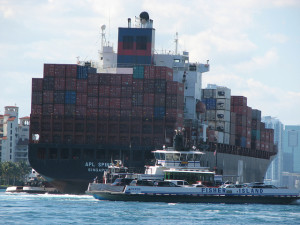 The logistics industry demonstrated its lowest confidence level yet in reaction to the unremitting difficulties besetting the sector, according to the latest Stifel Logistics Confidence Index.
The logistics industry demonstrated its lowest confidence level yet in reaction to the unremitting difficulties besetting the sector, according to the latest Stifel Logistics Confidence Index.
In the December edition of the index, the segment posted an overall score of 45.4, “its lowest ever total, amidst a continued pattern of decline,” said a report by research provider Transport Intelligence which conducts the monthly survey.
The Europe-U.S. lane continues to be the most positive of the four trade lanes covered, representing the highest scoring route across both air and sea as well as current and expected situation. The optimism derives from the continued strength of the U.S. dollar against the Euro, helping to boost performance. By contrast, the performance of trade lanes between Europe and Asia, in both directions, continues to be poor.
Within the airfreight industry, increasing numbers of passenger planes, combined with “a tough global economic environment and feeble world trade,” is resulting in increasingly poor load factors as the underlying capacity problem remains.
But for the shipping industry, steps are now being taken to tackle the overcapacity crisis. Maersk has committed to lay up an 18,000-TEU vessel last month, while CMA CGM has agreed to acquire the struggling Neptune Orient Lines, even as a merger between China’s state-owned giants China Shipping and COSCO is in the offing.
“The projected consequences of these deals will see the lines involved in the round of consolidation, along with industry leaders Maersk and Mediterranean Shipping Company, control nearly half of global container shipping capacity,” said the report.
For airfreight, the total logistics confidence Index contracted by 2.3 points in December 2015, amounting to 46.6, which is 9.2 points lower than in December 2014, and 9.8 points lower than in December 2013. On the present situation, the index fell by 1.6 points. Now a well-established pattern, all lanes posted month-on-month declines except for the Europe-U.S. lane, which gained 1 point. By contrast, the U.S.-Europe sling lost 3.5 points, while Asia-Europe and Europe-Asia lost 1.1 and 3.1 points, respectively.
In the six-month outlook, the pattern of decline persisted, as expectations fell 3 points. Europe-Asia recorded the slightest change out of the four lanes, having fallen by 0.1 point. Following this was U.S.-Europe, which was down 1.5 points. While Europe-U.S. stood out once more as a positive, it also recorded a significant month-on-month decline of 4.6 points. Worse was Asia-Europe, which lost 5.5 points in December.
For sea freight, players’ confidence declined by 1.8 points to 44.3, or 14.7 points lower year-on-year, and also 14.3 points lower than in December 2013.
For the present situation, the index fell 3.3 points. All lanes noted declines in December, though Europe-U.S. lost only 0.8 point to remain in a stronger position than the others. Down by 4.7 points from November, Europe-to-Asia was the weakest of the lanes. Asia-Europe noted an even greater decline of 5 points. U.S. to Europe recorded a moderate loss of 2.6 points.
The expected situation for sea freight was more positive than the present situation, with a 0.2 point decline in the index. Europe-U.S. saw the most positive result, gaining 0.8 point, while Asia-Europe similarly gained 0.7 point. Europe-Asia saw a 0.3 point decline, but U.S. to Europe was down 2.1 points.
Photo: Derek





